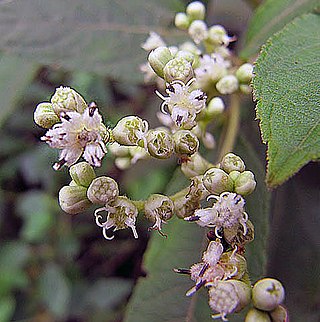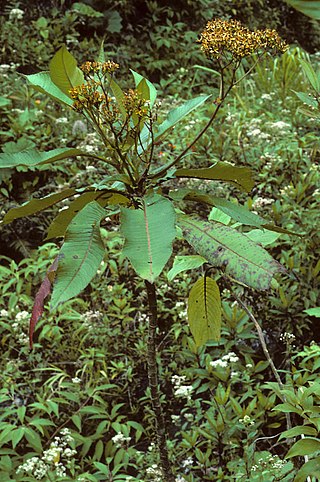
Senecio is a genus of flowering plants in the daisy family (Asteraceae) that includes ragworts and groundsels.

Aequatorium is a genus of flowering plants in the aster family. It was described as a genus in 1978. It is a member of the tribe Senecioneae and native to South America.

Clibadium is a genus of flowering plants in the family Asteraceae.

Critonia is a genus of flowering plants in the tribe Eupatorieae of the family Asteraceae.
Dendrophorbium is a genus of South American flowering plants in the family Asteraceae.

Pentacalia is a genus of flowering plants in the family Asteraceae. About 34 members of this genus appear to be located in the South American county Ecuador, where they are threatened by habitat loss. The genus contains approximately two hundred species, which are distributed from Mexico to northern South America.

Pseudogynoxys is a genus of flowering plant in the groundsel tribe within the sunflower family, native to North and South America.

Pectis is a genus of flowering plants in the family Asteraceae described as a genus by Linnaeus in 1759.
Nordenstamia is a genus of flowering plants in the family Asteraceae.

Jessea is a genus of Central American plants in the tribe Senecioneae within the sunflower family, closely related to Senecio.

Wurmbea is a genus of perennial herbs in the family Colchicaceae, native to Africa and Australia. There are about 50 species, with about half endemic to each continent.
Lourteigia is a genus of South American flowering plants in the tribe Eupatorieae within the family Asteraceae.

Psacalium is a genus of flowering plants in the sunflower family. Indianbush is a common name for Psacalium.

Montanoa is a genus of flowering plants in the tribe Heliantheae, within the family Asteraceae.
Odontocline is a genus of Jamaican flowering plants in the daisy family.

Jesse More Greenman was an American botanist. He specialized in tropical flora, with emphasis on plants from Mexico and Central America. He was an authority on the genus Senecio and noted for his work at the Missouri Botanical Garden.

Lamourouxia is a genus of flowering plants belonging to the family Orobanchaceae.
Seymeria is a genus of flowering plants belonging to the family Orobanchaceae.













